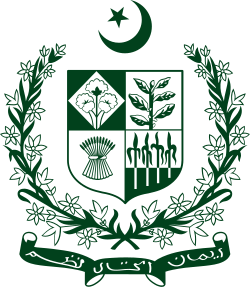Emblem of Pakistan
| State Emblem of Pakistan | |
|---|---|
 |
|
| Details | |
| Armiger | Islamic Republic of Pakistan |
| Adopted | 1954 |
| Crest | Green star and crescent |
| Escutcheon | The quartered shield in the centre shows cotton, wheat, tea and jute |
| Supporters | Floral wreath |
| Compartment | The scroll supporting the shield contains the national motto in Urdu |
| Motto |
ایمان، اتحاد، نظم "Faith, Unity, Discipline" |
| Earlier versions | 1947–1955: 
|
The state emblem of Pakistan was adopted in 1954 and symbolizes Pakistan's ideological foundation, the basis of its economy, its cultural heritage and its guiding principles. The four components of the emblem are a crescent and star crest above a shield, which is surrounded by a wreath, below which is a scroll. The crest and the green colour of the emblem are traditional symbols of Islam. The quartered shield in the centre shows cotton, wheat, tea and jute, which were the major crops of Pakistan at independence and are shown in a form of shield and signify as the main agricultural base for the importance of the Nation's economy. The floral wreath, surrounding the shield, is Jasminum officinale (the national flower) and represents the floral designs used in traditional Mughal art and emphasizes the cultural heritage of Pakistan. The scroll supporting the shield contains the national motto in Urdu, "Īmān, Ittiḥād, Naẓm", which reads from right to left: (ایمان، اتحاد، نظم), translated as "Faith, Unity, Discipline" which are intended as the guiding principles for Pakistan.
Emblem of the Supreme Court
Emblem of the Federal Shariat Court
Emblem of the Election Commission
Emblem of the Oil & Gas Regulatory Authority
...
Wikipedia
